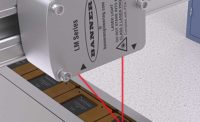Assembly machines are dumb.
They can only do what they’re told, over and over again. Without a sense of sight or touch, they can’t know if parts or pallets are where they’re supposed to be. A robot or pick-and-place unit will perform its preprogrammed motion regardless of whether the gripper has successfully picked up a part. If that part fails to get added to the workpiece, the pallet will still be passed to subsequent stations, which will mindlessly add value to a worthless assembly.
That’s why multistation automated assembly systems are festooned with sensors. To name a few, there are sensors to detect the presence of a part; sensors to verify that a cylinder has actuated; sensors to measure parts or verify assembly; and sensors to count finished assemblies.
“Sometimes, you just want to make sure a part is present. Other times, you want to know if it’s the correct part. Or, depending on what’s being done at that station, you might want to ensure that the part is positioned correctly,” says Mike Montgomery, technical marketing manager at Keyence Corp. of America, a supplier of sensors, vision systems, controllers and other technology.
“Another task we see a lot is measurement,” he continues. “You want to ensure that a process has been performed correctly, so there might be a visual inspection with a vision sensor or a dimensional inspection with a laser sensor or a touch probe. You don’t want to add value to a part that’s already bad.”
Consider a single station equipped with a pneumatic, two-axis pick-and-place unit and supplied by a vibratory feeder bowl. A sensor notifies the unit whenever a pallet is present and ready to accept a part. Another sensor tells the unit that a part is available for pickup at the end of the feed track. A third sensor monitors the amount of parts in the bowl, to ensure the system never runs out.
Each time the X-axis cylinder reaches the end of its stroke, a sensor tells the Y-axis cylinder that it’s OK to extend to pick or place a part. When that cylinder reaches the end of its stroke, a sensor signals the gripper to open or close. Yet another sensor, attached to the gripper, tells the unit that a part has been picked up.
That’s six sensors for just one operation. Incredibly, the very next station in the system might very well be another sensor to confirm that the part has been placed correctly.
“If you can’t sense it, you can’t automate it,” says Tom Rosenburg, director of marketing at Balluff Inc., a supplier of sensors, networking gear, RFID systems and other control technology.
Myriad sensing technologies see use in automated assembly systems, including photoelectric sensors, inductive proximity sensors, ultrasonic sensors, magnetostrictive position sensors, laser sensors, eddy current displacement sensors, and touch probes. And that doesn’t include machine vision, which is a whole other ball of wax. Which sensor to use depends on the application, size constraints, response time, the material being sensed, electrical interface requirements, reliability, resolution, cost and environment.
“Depending on the machine, the number of sensors we use can vary from 10 to 60,” says Brian Romano, manager of control systems engineering at systems integrator Arthur G. Russell Co. Inc. “Some of our machines are based on multilane feeders and production cells. These machines might have two rows of 20 sensors to detect part loading and other actions.”
Photoelectric Sensors
Photoelectric sensors might be the most common sensor used in automated assembly systems. “We use several kinds of sensors in our machines, including vacuum sensors, pressure sensors, ultrasonic level sensors, proximity sensors and vision sensors,” notes Romano. “But, a good majority of the sensors used in our equipment are photoeyes of one type or another.”
Photoelectric sensors can be used for detecting parts, counting parts, verifying colors, measuring objects, detecting marks, or sensing changes in surface conditions. A photoelectric sensor consists of a light source, a receiver, and components to evaluate and amplify the detected signal. When emitted light is interrupted or reflected by the target, it changes the amount of light that arrives at the receiver. The receiver detects this change and converts it to an electrical output.
The light source for most photoelectric sensors is infrared or visible light (usually red). Sensors for detecting very small parts use a fiber optic light source or a laser.
The main advantage of photoelectric sensors is that they can detect virtually any material, including metal, glass, plastic, wood and liquid. (Inductive proximity sensors can only detect metal objects.) Other advantages include fast response times, high resolution, long sensing distance, and simple setup.
Photoelectric sensors come in through-beam, diffuse and retroreflective models.
Through-beam sensors have separate emitter and receiver units. The units are aligned so that the greatest possible amount of light from the transmitter reaches the receiver. When the target crosses the path of the light beam, it blocks light to the receiver. This causes the receiver’s output to change state. When the target no longer blocks the light path, the receiver’s output returns to its normal state.
Through-beam sensors are good for detecting opaque or reflective objects. They are less suitable for detecting transparent objects.
“A self-contained, fork-shaped through-beam sensor is one of our best-selling product lines,” says Rosenburg. “The No. 1 application for this sensor is sensing parts coming out of a feeder bowl.”
Retroreflective sensors contain the emitter and receiver in one unit. Light from the emitter is transmitted in a straight line to a reflector and returns to the receiver. When a target blocks the light path, the output of the sensor changes state. When the target no longer blocks the light path, the sensor returns to its normal state.
Unlike through-beam sensors, retroreflective sensors cannot detect shiny objects. Shiny objects reflect light back to the sensor. Therefore, the sensor can’t differentiate between light reflected from the object and light returning from a reflector.
Like retroreflective sensors, diffuse mode sensors contain the emitter and receiver in one unit. However, light from the emitter strikes the target, and the reflected light is diffused from the surface at all angles. If the receiver receives enough reflected light, the output will switch states. When no light is reflected back to the receiver, the output returns to its original state.
One of the newest applications for photoelectric sensors is color recognition. These sensors “read” colors by emitting white light and then measuring the levels of light reflected back in the red, blue and green wavelengths. These levels are compared to a value stored in the sensor’s memory. If the value is within specific tolerance limits, recognition of that value triggers the output.
Applications for color recognition sensors include sorting by product color or matching a memorized color to that of a passing target. “You can use a color recognition sensor to ensure that the right part has been installed. Has that red O-ring been installed in the black fuel injector?” says Rosenburg.
Proximity Sensors
Inductive proximity sensors are also commonly used in automated assembly systems. These noncontact sensors detect metallic targets at distances of less than 2 inches. Proximity sensors emit an alternating electromagnetic sensing field. When a metal object enters the field, eddy currents are induced in the target, reducing signal amplitude in the sensor and triggering a change of state at its output.
Unlike photoeyes, “prox sensors” are insensitive to the color or surface finish of the target. They’re also unaffected by vibration, water, oil, dirt and nonmetallic particles.
“An inductive proximity sensor is one of the least expensive sensors,” explains Rosenburg. “If you want to verify that a pallet has entered a station, an inductive proximity sensor is the best choice.”
Making Connections
With so many sensors on automated assembly systems, engineers need an easy way to connect sensors and actuators with PLCs, HMIs and shop-floor networks.
“IT is more involved [in assembly system design] than ever before,” notes Montgomery. “I find myself talking to IT people all the time, whereas three or four years ago, I never did. Sensors are being hooked up to a network.”
One solution to the connectivity issue is IO-Link. Introduced in 2009, IO-Link is an open, standardized I/O technology (IEC 61131-9) for communicating with sensors and actuators. This point-to-point system is based on the familiar three-wire sensor and actuator connection. IO-Link is not a fieldbus, but a refinement of an existing, proven connection technology for sensors and actuators.
“Think of it as USB for industry,” explains Rosenburg. “It’s very simple. You can get diagnostic information and positional information, and get it all back to your main data collection system or PLC.”
The connection between IO-Link master and device is established via an unscreened three-wire cable with a maximum length of 20 meters. The wiring is standardized on M5, M8 and M12 connectors. Most IO-Link devices are equipped with M12 connectors, which can be used without any restrictions for IO-Link’s switching mode and communication mode. Each port of an IO-Link master can process binary switching signals and analog values. Serial IO-Link communication takes place via the same port.
Numerous sensor and automation component suppliers have adopted the IO-Link standard, including Balluff, Banner Engineering Corp., Beckhoff Automation, Bosch Rexroth Corp., Festo Corp., Mitsubishi Electric Corp., Pepperl + Fuchs Inc., Sick Inc., Siemens and Turck Inc.
“One trend we’re seeing in automated assembly lines is the need for flexibility,” says Rosenburg. “Companies want to build more than one product on a line. So, a lot of sensors are moving away from discrete signals. That is, the sensor is either on or off. Now, more sensors are providing analog signals.
“With a gripper, for example, the jaws might be open X amount for one part, but a little more for another part. An analog position sensor allows the gripper to adjust on the fly based on what product is being assembled. With IO-Link, analog signals are inexpensive to handle.”











